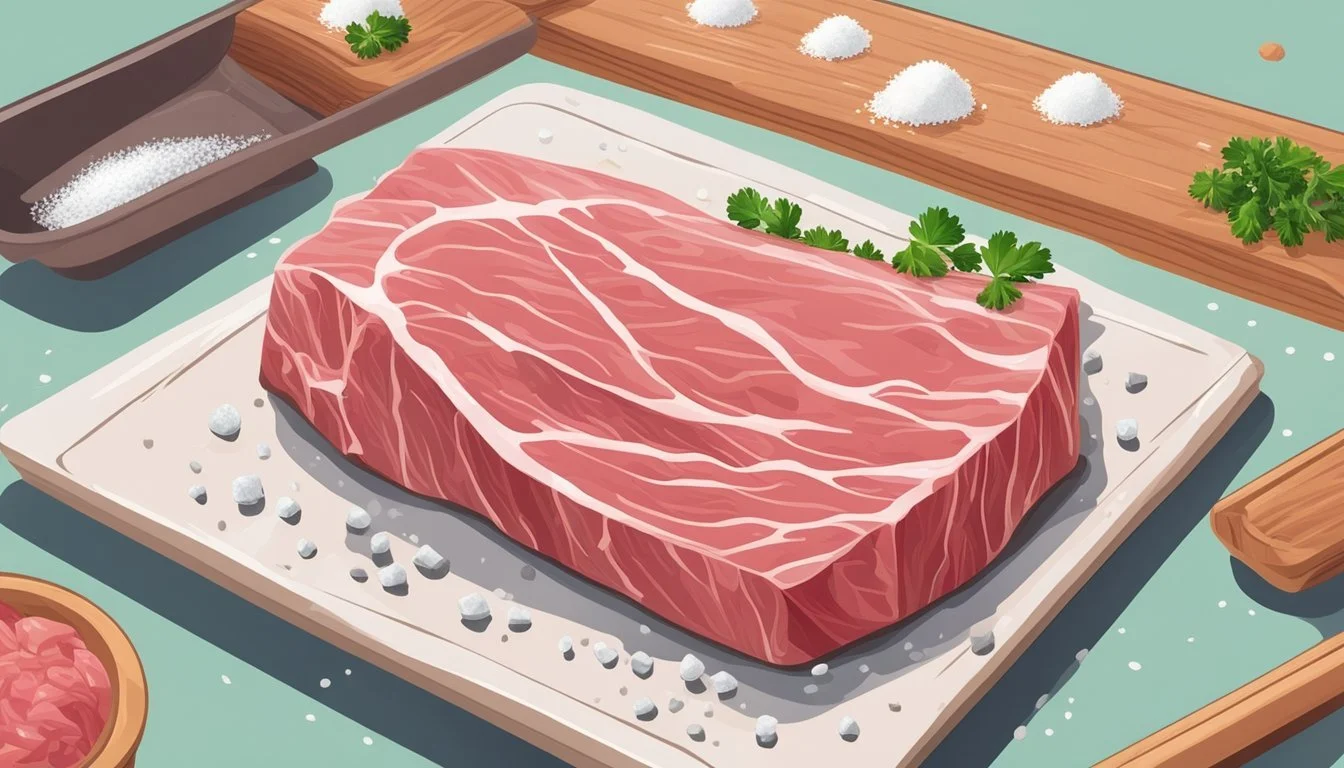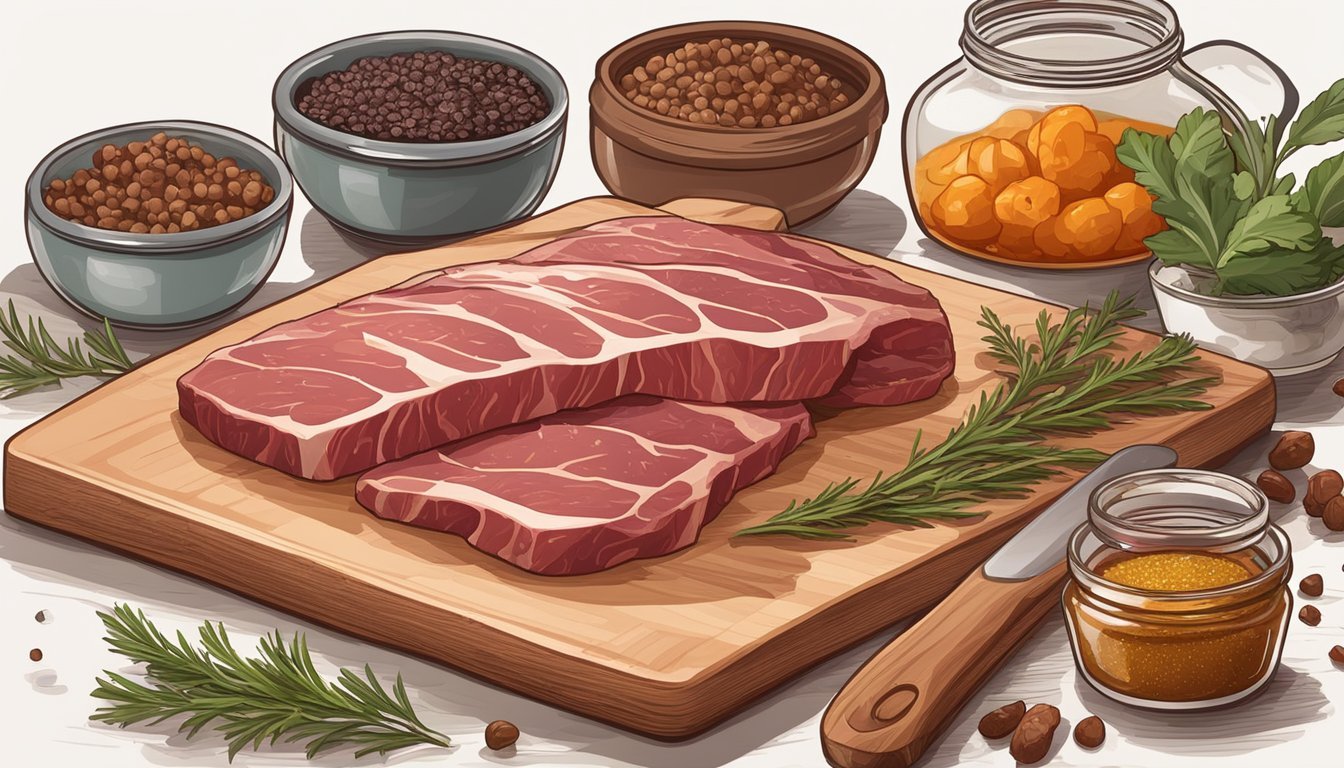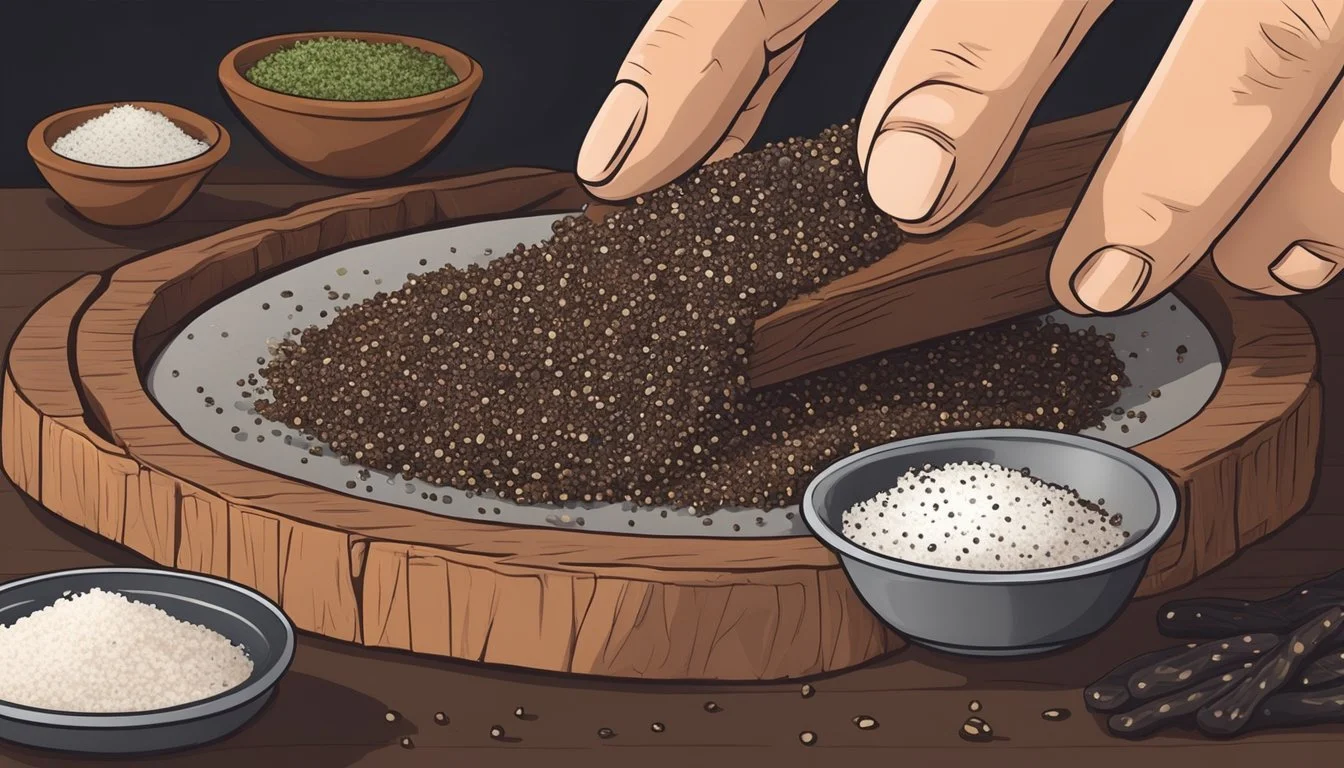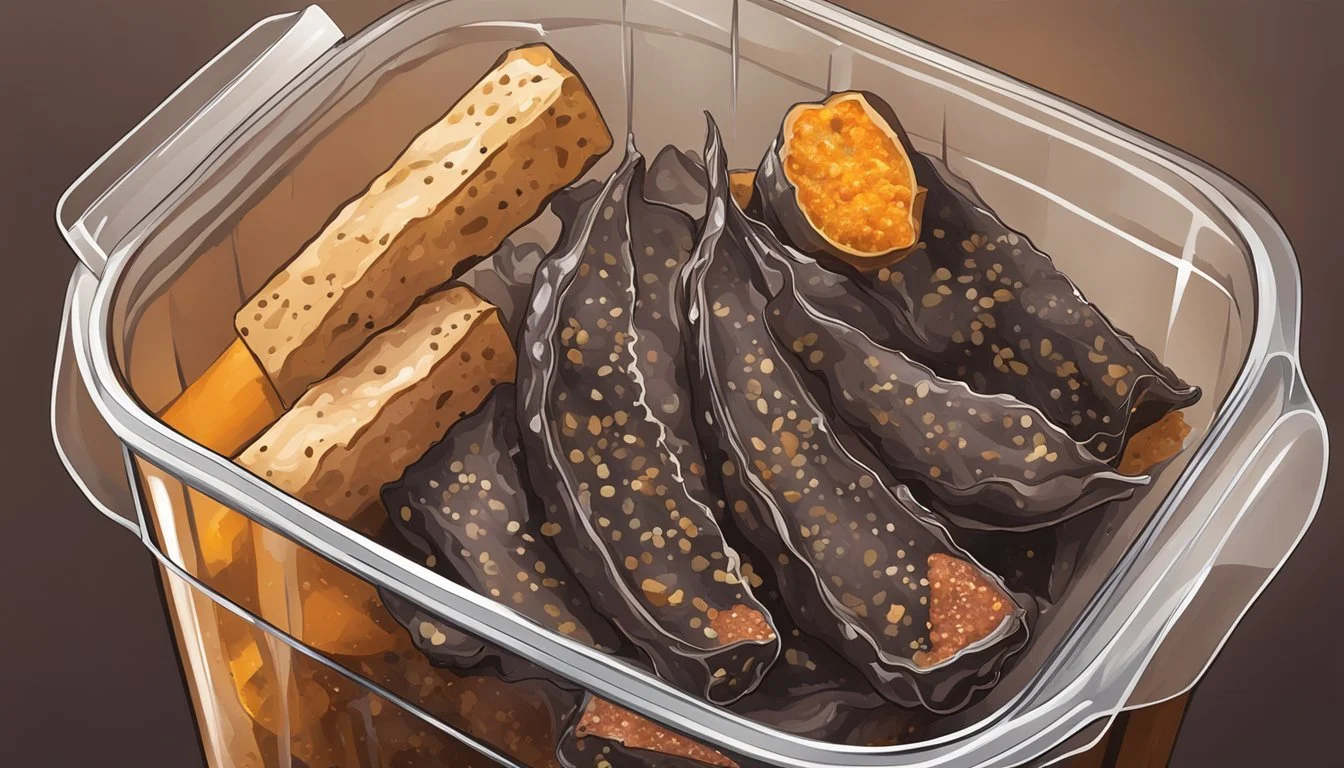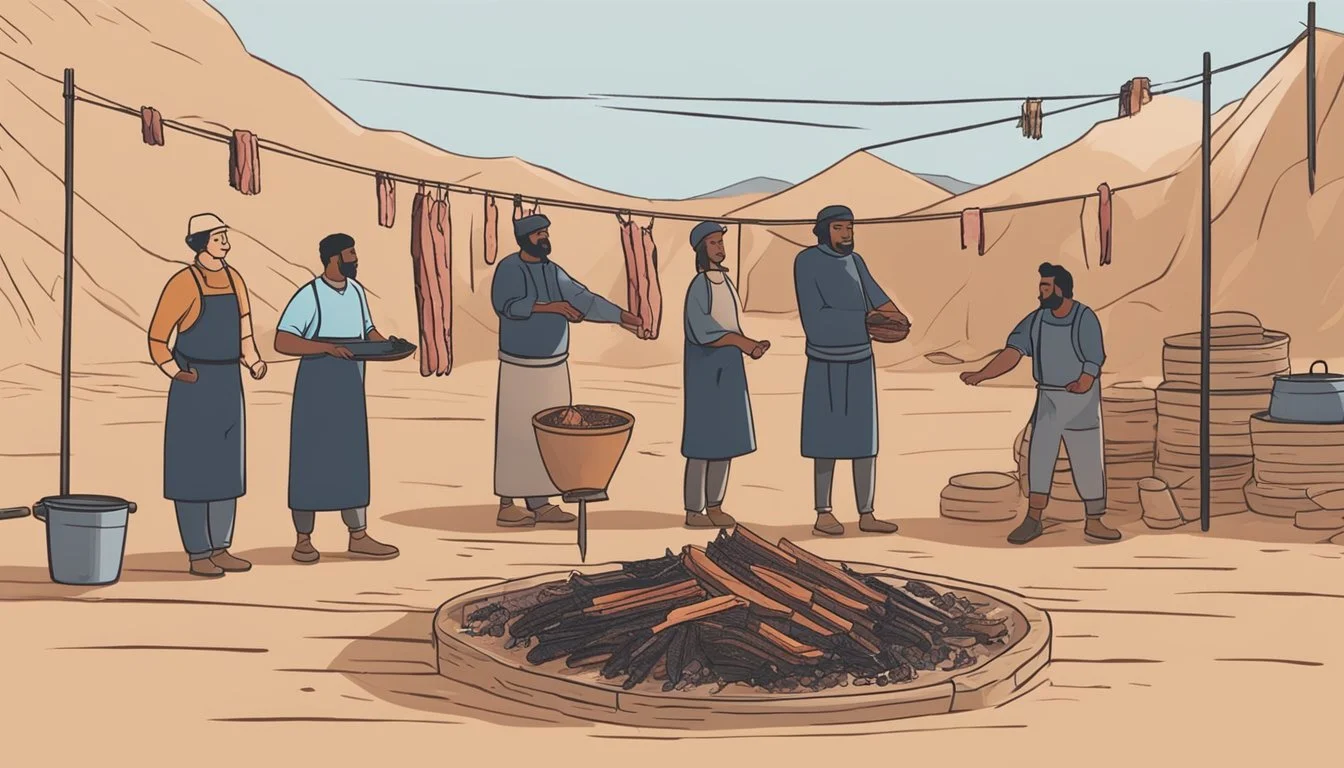How to Ferment Biltong
Mastering South African Dried Meat Techniques
Biltong is a traditional South African dried meat revered for its savory flavor and distinctive preparation process. Originating from the culinary practices of indigenous tribes and early Dutch settlers, biltong has become a cultural staple and a sought-after delicacy beyond the borders of South Africa. Unlike typical jerky, biltong fermentation and drying include unique ingredients such as rock salt, coriander, black pepper, and vinegar, which contribute to its characteristic taste and texture.
The process of making biltong involves the fermentation of meat, which is key to developing its rich umami profile and ensuring its preservation. It begins with selecting the appropriate type of meat, commonly lean cuts of beef, although game meats like venison (What wine goes well with venison?) are also popular alternatives. The chosen meat is then cut to size, seasoned with the traditional spices, and submerged in a vinegar solution that initiates the fermentation. This mild acidification, combined with the dehydrating effect of salt, provides an environment conducive to fermentative bacteria while inhibiting spoilage organisms.
As the fermentation stage lays the groundwork for flavor and safety, the subsequent drying phase is critical to achieving the correct moisture content and texture. The meat is typically hung in a well-ventilated area or a specialized biltong maker where it can cure slowly. The duration of the drying process varies based on factors such as climate, meat thickness, and desired dryness, stretching from a day up to several days until the biltong reaches the perfect consistency. Whether enjoyed as a snack, culinary ingredient, or byproduct of heritage, the making of biltong is a careful blend of science and art passed down through generations.
History and Origins
Biltong is a traditional South African dried meat that is deeply entwined with the history of the region. The word "biltong" is derived from the Dutch words "bil" (rump) and "tong" (strip or tongue), which succinctly describe the cut and shape of the dried meat.
Originating from the need for preserving meat in a hot climate, the indigenous peoples of South Africa, as well as Dutch settlers in the 17th century, developed the technique of air-drying meat. Dutch settlers, known as the Voortrekkers, adopted biltong as a staple for their long journeys during the Great Trek—a mass migration through the South African interior to escape British rule.
The pioneers utilized spices such as coriander, salt, and vinegar, elements abundant in the Cape Colony, for the curing process. This method not only flavored the meat but also inhibited bacterial growth during the drying process. They carried and consumed biltong as they traversed the demanding landscape, valuing it for its durability and nutritional content.
In its traditional form, biltong is reflective of South Africa's diverse cultural heritage, symbolizing the adaptation and resilience of its inhabitants. From indigenous techniques to the influence of Dutch settlers, biltong's origins are a testament to the blending of practices and the ingenuity of those who valued resourcefulness in the face of harsh environmental challenges.
Selecting the Proper Meat
When fermenting biltong, the choice of meat is crucial as it directly affects the flavor, texture, and quality of the final product. The selection process focuses on identifying the ideal cuts and ensuring the meat's suitability for preservation.
Choosing the Right Cut
The best biltong is made from beef, although other meats like venison, kudu, ostrich (What wine goes well with ostrich?), and eland are also used. It's important to use lean cuts with minimal fat to prevent rancidity. These cuts include:
Silverside – A lean, flavorful choice from the hindquarter
Topside – Similar to silverside but slightly more tender
Eye of round – A very lean cut from the rear leg
The cuts should be sliced with the grain into long strips to maintain structure and chewiness.
Meat Quality and Preservation
Selecting high-quality, fresh meat is vital for a successful batch of biltong. The meat should have a good color and a firm texture, indicating proper handling and freshness. It should also be:
Well-sourced – Originating from reputable suppliers with a track record of safety and quality.
Protein-rich – Indicative of good nutrition which contributes to the taste.
For game meats like venison or kudu, it's essential to ensure the meat has been properly field-dressed and stored to avoid spoilage. In all cases, the meat's suitability for air-drying should be assessed, with preference given to naturally preserved options that enhance the biltong's distinctive characteristics.
Preparation and Ingredients
Creating the perfect biltong requires careful selection of ingredients and a methodical approach to preparation. This section outlines the steps needed to prepare biltong, from the initial trimming of the meat to the crucial marination process that infuses it with its distinctive flavors.
Trimming the Meat
One must commence by selecting a lean cut of beef, such as silverside, topside, or round steak. The meat should be trimmed of any excess fat and sliced into consistent strips, approximately 2 cm in width and 5 cm in length. This ensures even drying and optimal flavor absorption.
Mixing the Spices
A blend of spices is crucial for creating biltong's unique taste. The typical spice mix includes:
Coarse salt: for curing and flavor
Brown sugar: to balance the saltiness and aid in the curing process
Crushed coriander seeds: for their warm, citrus-like flavor
Cracked black pepper: for a piquant kick
Bicarbonate of soda: to help tenderize the meat
Vinegar: usually red wine or apple cider, for acidity and aiding the curing process
Paprika or chilli flakes: for a smoky or spicy note (optional)
These ingredients are mixed thoroughly to create a rich, flavorful marinade.
Marination Process
The strips of meat are first doused with vinegar to help with the curing. Then, the spice mixture is rubbed onto each strip of meat, making sure each piece is coated evenly. Once the meat is fully covered in spices, it should then be laid out on a tray lined with paper towels. The tray is covered with plastic wrap, and the meat is left to marinate. The duration of marination can vary, but typically the meat should rest in the refrigerator for several hours or overnight to absorb the flavors deeply.
After marination, the meat will be hung to dry in a biltong maker or biltong box, where controlled air circulation will cure the meat over several days until it reaches the desired level of dryness.
The Curing Process
The curing process of biltong is a delicate balance of drying and flavoring the meat. The steps followed ensure biltong's traditional texture and taste are achieved through carefully controlled application of cure and management of environmental conditions.
Layering and Curing Methods
To begin the curing process, the meat is traditionally sliced into consistent strips or thicker slabs, depending on personal preference. Layering involves alternating strips of meat with a curing mixture of salt, nitrates, and spices. This mixture facilitates osmosis, drawing out moisture to inhibit bacterial growth.
Lay meat strips in a single layer on a tray.
Generously apply the curing mixture to each layer.
Stack layers of meat, interspersed with more of the mixture.
Allow the meat to cure typically for several hours, depending on the recipe.
Curing can also include the addition of vinegar, which helps tenderize the meat and add tanginess to the flavor profile. Marination may follow, where the meat soaks in a blend of vinegar and spices before the drying process begins.
Managing Temperature and Humidity
Temperature and humidity play critical roles in producing high-quality biltong. The meat needs to dry at a consistent rate to avoid spoilage. A common practice is to hang the meat in a dry, well-ventilated area with a controlled climate.
Temperature: Ideal temperatures range from 10°C to 30°C; careful attention ensures the meat does not spoil.
Humidity: Relative humidity should be maintained around 40-60%.
Some producers opt to use a dehydrator or a biltong box where these conditions can be more easily controlled. For those in less ideal climates or without special equipment, a fridge can provide a suitable environment for drying, where temperature and humidity are more stable compared to room conditions.
Drying and Fermentation
When making biltong, the process of drying and fermentation is crucial to achieve the classic texture and flavor. Proper air circulation and temperature control are essential factors during this phase to prevent bacteria growth and ensure that the meat cures evenly.
Setting Up a Drying Environment
An optimal drying environment requires control over humidity and a means of air circulation to prevent the growth of bacteria. A biltong box is a purpose-built piece of equipment that provides a safe environment for drying meat. It typically includes a fan and may incorporate a light bulb for gentle heat, which assists in creating a consistent temperature and reducing moisture. The biltong box should be placed in a dry area where it will not be disturbed by flies or other contaminants. For home preparation without specialized equipment, a clean, well-ventilated room or a food dehydrator can suffice. The meat is usually hung on hooks or rods to allow for air movement around each piece.
Equipment: Biltong box or food dehydrator
Temperature: Consistent and cool
Air Circulation: Fan-assisted for even drying
Sanitation: Protection from insects and contaminants
Monitoring the Drying Time
The drying time for biltong can vary depending on several factors, including the thickness of the meat slices, the type of meat, humidity levels, and the desired texture. On average, the drying process can take anywhere from 24 hours to several days. The meat should be checked periodically, using paper towels to pat down any excess moisture observed on the surface. The ideal texture of biltong is firm to the touch, but not hard. One should also ensure that the drying environment maintains a consistent airflow and remains free of humidity, as this can affect the drying time and quality of the finished product.
Checklist for Drying Time:
Pat down excess moisture with paper towels.
Ensure consistent airflow and temperature.
Observe texture changes for signs of proper drying.
Adjust drying time based on the environment and meat thickness.
Through diligent monitoring and maintaining the correct conditions in the drying environment, one can produce high-quality, air-dried biltong with the perfect balance of texture and flavor.
Flavoring and Spicing Techniques
Biltong relies heavily on its distinctive spice blend for flavoring, which is paramount to create its unique taste. The spicing techniques used can significantly affect the final product's flavor profile.
Roasting and Grinding Spices
To maximize the potency of flavors in biltong, chefs often roast spices like coriander seeds and whole black peppercorns before grinding them. Roasting releases essential oils and enhances the spices' aromatics, leading to a richer taste. Here's how to prepare these spices:
Roast gently in a dry pan until they are fragrant.
Cool the spices before grinding to preserve the aromatic oils.
Grind the spices using a spice grinder or mortar and pestle to the desired consistency.
Enhancing Flavor Profiles
A variety of vinegars and sauces can be employed to further enhance the flavor profile of biltong. The main purpose of these is not only to impart distinct flavors but also to assist in the curing process. The choices commonly include:
Vinegars:
Apple cider vinegar
Balsamic vinegar
Red wine vinegar
Sauces:
Worcestershire sauce
Chefs typically marinate the meat in a mixture of vinegar and spices, turning it occasionally for even coverage. The specific vinegars impart subtle differences:
Apple cider vinegar provides a fruity tang.
Balsamic vinegar offers a sweet and rich flavor.
Red wine vinegar lends a sharp and robust note.
After the initial vinegar soak, the meat is coated generously with the spice mixture, often including roasted and ground coriander, black pepper, and other spices like paprika. For an optimal balance, chefs carefully measure the amount of each spice, adhering to the idea that less can sometimes be more when it comes to achieving the desired flavor complexity.
Storage and Preservation
Proper storage and preservation of biltong are crucial to maintaining its nutrition and flavor while preventing mold. Attention to environment and handling can ensure long-term enjoyment of this traditional South African delicacy.
Long-Term Biltong Storage
For optimal long-term storage, biltong should be kept in a cool, dry place. A refrigerator can provide the ideal environment, as it not only keeps biltong cool but also maintains a consistent temperature which is critical for preservation. If freezing is preferred, it should be done with the biltong in an airtight container or sealed plastic bag to prevent freezer burn and dehydration. Frozen biltong can last several months, but should be thawed slowly in the refrigerator to maintain its quality.
Recommended Storage Methods:
Refrigerator: Seal in an airtight container and store for up to 4 weeks.
Freezer: Place in a sealed bag or container, can last several months.
Mold Prevention Methods
Preventing mold on biltong involves controlling humidity and ensuring proper air circulation. Biltong hooks are an effective way to enhance air flow around the meat during the initial drying process, and they also come in handy for storage. Biltong should hang freely, preventing any sides from touching each other, thus discouraging mold growth. Preservatives such as vinegar and salt in the curing process not only add flavor but also inhibit mold formation. Additionally, inspecting the biltong regularly can catch any signs of mold early, allowing for immediate corrective action.
Key Points in Mold Prevention:
Air Circulation: Use biltong hooks for hanging and ensure biltong does not touch other surfaces.
Humidity Control: Keep the storage area dry; consider using a dehumidifier if necessary.
Inspection: Regularly check for any signs of mold and take immediate action if detected.
Serving and Usage
After fermenting biltong, it becomes a versatile snack that can be savored on its own or used as a flavorful addition to various dishes.
Cutting and Presentation
When serving biltong, the way it's cut can significantly influence its flavor and texture. One should cut biltong against the grain for a tender chew or along the grain for a more robust texture.
Thin slices: Offer a more delicate taste suitable for snacking.
Thick strips: Provide a substantial bite, often preferred for hearty appetites.
Presentation plays a role in enhancing the experience of enjoying biltong. Serving on a wooden board along with cheese, crackers, and pickled accompaniments showcases its rustic appeal. Biltong hooks, often used in the drying process, are helpful for displaying the meat in a striking and traditional manner.
Incorporating into Dishes
Biltong's rich flavor profile makes it an excellent protein-packed addition to a variety of dishes. It should be incorporated according to personal taste preferences and the dish's flavor palette.
Salads: Chopped biltong adds a savory punch to greens.
Pizzas: When used as a topping, biltong infuses a unique twist to the classic dish.
Quiches: Small pieces can punctuate these with a dose of intense flavor.
When used in cooking, one must account for biltong's inherent saltiness and adjust the seasoning of their dishes accordingly. This healthy snack not only provides a considerable amount of protein but also enhances meals with its complex, robust taste, distinguishing it from the common beef jerky.
Culinary Variations
Biltong's preparation comes with a variety of techniques that hinge on personal tastes and regional traditions. South Africans and Namibians have crafted biltong into a cultural staple, often with subtle differences in flavor and preparation methods.
Traditional Biltong stands out for its robust flavor, oftentimes incorporating vinegar, salt, coriander, black pepper, and sometimes a hint of sweetness. The air-drying process can vary, with some opting for a biltong maker, a specialized apparatus that facilitates consistent air flow and temperature control, while others may use a dehydrator for faster results.
Flavor: Traditional recipes can be tweaked to enhance sweetness or spice levels. While some purists keep it classic, modern variants include:
Garlic powder
Chili flakes
Brown sugar for added sweetness
Biltong Boxes and Biltong Hooks: These tools are essential for proper air circulation during the drying process. Hooks are used to hang the meat vertically inside a biltong box— a container designed to simulate the ideal drying environment.
Biltong Maker: Use - Provides optimal conditions for fermentation.
Dehydrator: Use - Accelerates the drying process for quicker results.
Biltong Box: Use - Traditional method for hanging and drying meat.
Biltong Hooks: Use - Used to hang meat strips ensuring even drying.
The primary difference between South African biltong and North American beef jerky lies in their moisture content and texture. Biltong retains a more tender interior due to variations in thickness and length of fermentation. While jerky is often smoked and dried to a crisp, biltong provides a chewier and often more flavorful experience.
Travellers often find that biltong fits perfectly into their on-the-go lifestyle, offering a portable and satisfying option among dried meats. As biltong continues to gain global popularity, the culinary variations expand, providing a canvas for continuous innovation while staying true to its South African roots.
Health and Nutrition
Biltong is often celebrated as a healthy snack option due to its nutritional profile. Rich in protein, it provides an excellent source for muscle repair and body maintenance. As a lean meat product, biltong is typically low in fat, especially if made from cuts such as silverside or topside.
The snack's preparation method contributes to its health benefits. The curing process preserves the meat without needing additives, often resulting in a product lower in preservatives compared to other snacks (What wine goes well with snacks?). Here's a brief look at biltong’s nutritional composition:
High in protein: Essential for muscle repair and growth.
Low fat: Particularly when prepared with lean meats.
Low carbohydrate: Ideal for those following a low-carb diet.
Furthermore, the snack provides a decent amount of vitamins and minerals such as iron, zinc, and vitamin B12, important for blood formation and cognitive health. When opting for biltong as a snack, one should consider portion sizes to manage sodium intake, as it may be higher due to the curing process.
Nutritional Information (approximate per 25g serving):
Calories: 50-80 kcal
Protein: 10-15g
Fat: 0.5-3g
Carbohydrates: 0-1g
Sodium: 200-600mg
It should be noted that while biltong is a nutritious option, it should be consumed in moderation as part of a balanced diet. This snack can be particularly beneficial for athletes or individuals requiring high-protein diets.
Making Biltong at Home
Making biltong at home allows individuals to enjoy this South African delicacy with customized flavors to suit personal tastes. The process requires some basic equipment and the personalization of the biltong recipe.
DIY Biltong Equipment
To begin, one needs to gather the necessary tools to create a biltong maker or as a substitute, utilize a dehydrator. Biltong equipment often includes:
Hooks or paper clips: To hang the meat strips.
Drying box or cabinet: A dedicated space for air circulation.
Fan: For constant airflow.
Light bulb: Provides gentle heat if needed.
Alternatively, using a dehydrator set to a low temperature can produce biltong in less time, but traditionalists prefer air-drying. The meat must hang freely, so ensure there's enough space between the strips for adequate airflow.
Personalizing the Biltong Recipe
Adjusting the recipe for homemade biltong can cater to one's personal taste. Traditionally, biltong is marinated with a mix of:
Coarse salt
Crushed coriander
Black pepper
Vinegar (usually cider or malt)
Additional spices such as paprika can be added according to preference.
After marination, the meat strips—ideally thin for quicker drying—are hung to cure. The duration of drying affects the texture, with some preferring a moist center, while others may opt for a fully dried result. Each ingredient's quantity can be tweaked, but care should be taken not to over-salt as this can toughen the meat.
Cultural Significance
Biltong is a traditional South African delicacy that symbolizes much more than a food item—it's a reflection of heritage, resilience, and communal identity. In South Africa, biltong bears the mark of a long-standing tradition that has been passed down through generations. The preservation of meat, a necessity in the past for the survival of travelers and hunters, has transformed into a craft that honors the meticulous methods of preparation unique to this region.
South Africans take great pride in their biltong-making process, which often utilizes various types of game meat, indicative of the country's biodiversity. This practice is not only prevalent in South Africa but also in neighboring Namibia, where similar traditions are upheld.
Preservation: Demonstrates historical innovations in food longevity
Game Meat: Showcases the use of local fauna, linking cuisine to environment
Flavor Profile: Reflective of South African palates and spice preferences
It's common for visitors to South Africa and Namibia to encounter biltong as an essential part of their travel experience, offering them a taste of local culture through a culinary lens. Biltong serves as an edible cultural ambassador, introducing people to a facet of Southern African society.
Throughout the various communities in South Africa, biltong is more than sustenance; it is a centerpiece in festivities and a bonding element during social gatherings. It represents a communal culinary pride and is a tangible link to a shared cultural history.
FAQs and Troubleshooting
Why is my biltong moldy?
Mold can occur if there's insufficient air circulation, if the temperature is too high, or if there is too much humidity. Ensuring good airflow in your biltong box and maintaining a consistent temperature around 20-22°C can help prevent mold. Check regularly during the drying process for any signs of mold, and if spotted, remove the affected areas immediately.
How do I stop flies from getting to the biltong?
Flies are attracted to the meat during the drying process. To prevent them, ensure that your biltong is covered with a fine mesh or netting at all times. Moreover, using a biltong box with fitted mesh panels can be an effective barrier.
What's the ideal drying time for South African biltong?
The drying time varies based on meat thickness and environmental factors, but generally it takes between 2 to 5 days. Thinner strips may require less time, while thicker ones might need more. It's ready when the outside is hard, and the inside remains slightly moist but not wet.
My biltong is too tough, what did I do wrong?
Biltong can become tough if it's dried for too long or the pieces are cut too thin. Make sure to slice the meat in uniform thickness and monitor it closely after the third day to achieve your desired level of dryness.
Can biltong be made while traveling?
Making biltong while traveling can be challenging due to varying temperature and humidity. Portable equipment like a travel biltong box is necessary. Choose a design that's compact and allows sufficient airflow for evenly dried biltong.
In summary, troubleshooting biltong involves proper temperature control, adequate air circulation, protection from pests, and careful timing. Each stage of preparation, from curing to drying, requires close attention to ensure the highest quality South African biltong.
Glossary of Terms
Biltong: A type of dried meat originating from South Africa. Traditionally made from beef, it can also be prepared with game meats.
Dried Meat: Meat that has had most of the moisture removed for preservation purposes. Biltong is a form of dried meat uniquely seasoned and cured.
Biltong Box: A drying chamber designed for biltong. It provides proper air circulation and protection during the drying process.
Biltong Maker: An apparatus or setup used for making biltong. It includes the biltong box, hanging rods, or hooks and may have a built-in fan for air flow.
Coriander Seeds: A spice from the cilantro plant, used whole or ground in biltong spices for its lemony citrus flavor when crushed.
Black Peppercorns: Dried berries that provide a hot, pungent flavor. It's cracked or ground as a crucial component of biltong spices.
Biltong Hooks: Hooks used to hang strips of meat in a biltong box or maker to allow for even air-drying.
Biltong Spices: A mixture that typically includes coriander seeds, black peppercorns, brown sugar, coarse salt, and sometimes additional flavors such as paprika or chili flakes.
Paper Towels: Used during the preparation of biltong to pat meat dry and to absorb any excess marinate before hanging the meat to dry.
Each term has been selected to provide a clearer understanding of the processes and components involved in fermenting biltong, thereby ensuring a confident grasp on the subject.
Conclusion
Biltong, a traditional South African dried meat, serves as a healthy snack rich in protein. The process of preparing biltong involves a series of steps that ensure its rich flavor and distinctive texture. Quality meat, typically lean cuts such as silverside or topside, is the foundation. Through thoughtful preparation, including the application of vinegar and spices, the meat's flavors are enhanced.
The drying process, crucial to biltong's character, can span from one to several days, depending on various factors such as the thickness of the meat slices and the dehydration method. Whether one uses a homemade biltong box or a modern dehydrator, careful monitoring is essential to achieve the desired dryness and texture.
In South Africa, recipes passed down through generations have perfected the art of biltong fermentation. It stands not only as a culinary delight but also as a symbol of cultural heritage. One can personalize biltong with a variety of spices, creating a customized snack that caters to individual tastes while preserving the essence of this time-honored treat.
For those interested in creating their biltong at home, clear instructions and adherence to food safety guidelines will lead to successful fermentation. Biltong offers a unique experience, embodying the rich flavors and traditions of South Africa.

